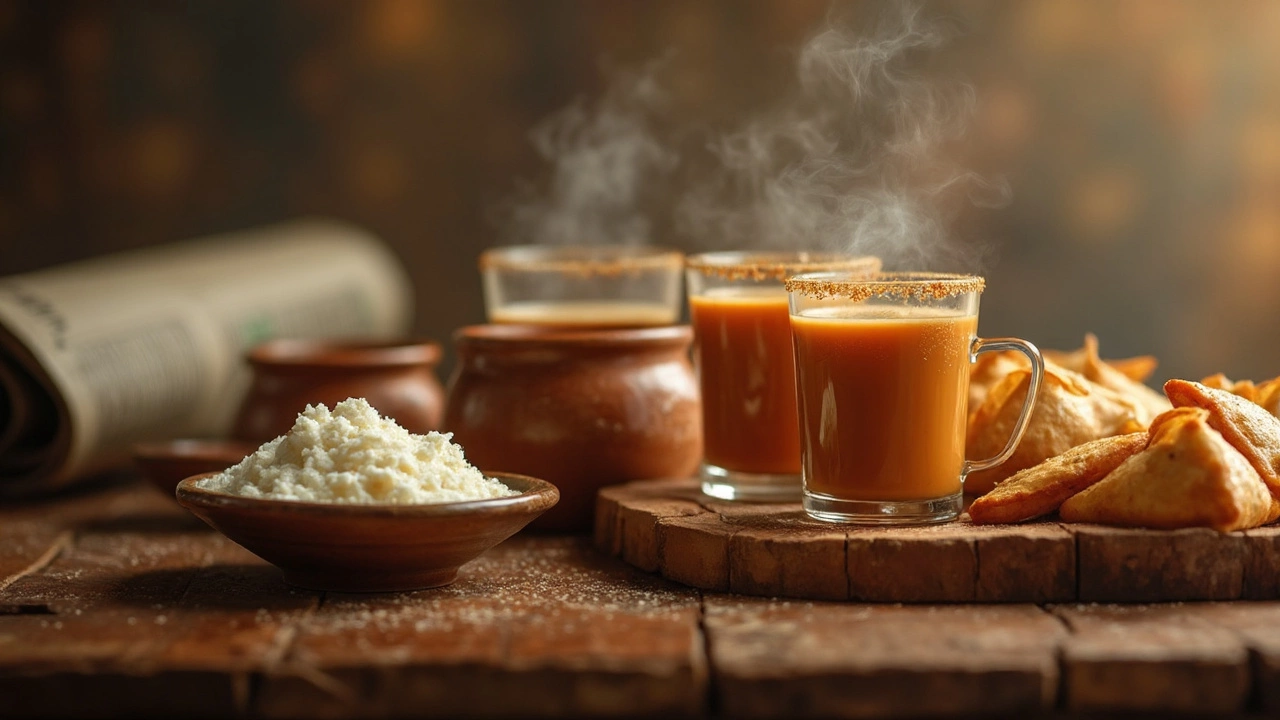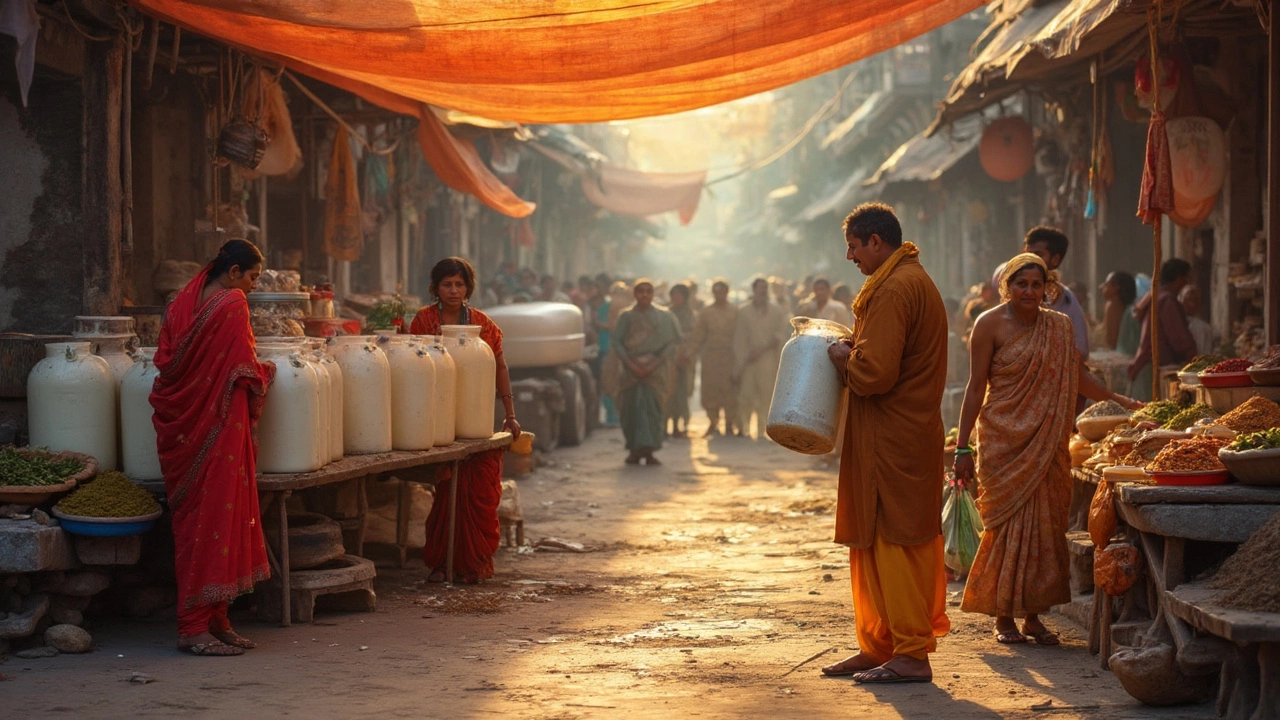Ever wondered what kind of milk lands in the glass after an Indian meal? It’s not always the cow’s milk most folks think of. Buffalo milk is actually the big favorite in India, and it changes the taste and texture of everyday recipes.
If you’re picking milk for chai, yogurt, or even just a cold glass, it’s good to know there’s a huge difference between types. Indian buffalo milk is creamier and richer than what you get from cows. That extra fat makes desserts like kheer turn out thick and dreamy, and chai a bit more velvety. Cow’s milk is common too, but it’s considered lighter—some people even mix the two to strike a balance.
- The Most Popular Milks in India
- Why Buffalo Milk Tops the List
- Regional Varieties and Specialties
- Milk in Indian Cooking and Drinks
- How to Choose (or Find) Indian-Style Milk
The Most Popular Milks in India
Walk into any Indian home, and you’ll most likely find buffalo milk in the fridge first. It’s not just a city thing—buffalo milk makes up around half of all milk produced in India. That’s a big deal. Why? Because it’s richer, with higher fat, which means it’s perfect for thick, creamy desserts, hearty chai, and homemade yogurt. Farmers love buffalos since they’re hardy and need less fancy feed compared to cows, making the milk a top choice even in smaller villages.
Cow milk is next in line. It’s especially common in southern and western states like Karnataka and Maharashtra. Cow milk is lighter and sometimes easier to digest, which is why many families with kids or elders use it just for drinking. But it doesn’t have that heavy creaminess you get from buffalo milk, so recipes turn out a bit different.
For folks in rural areas, there’s also goat milk—handy for people with small herds but it’s not sold much in cities. Sheep milk and even camel milk pop up in certain niches, like in Rajasthan. But for everyday breakfasts, chai, or laddus, it’s buffalo and cow milk all the way.
- Indian milk mostly means buffalo or cow milk in stores and recipes.
- Buffalo milk works best for sweet dishes and thick tea.
- Cow milk is usually preferred for drinking, especially for kids or people who want something a bit lighter.
If you’re trying to make Indian recipes outside India, check your local store. Sometimes, “whole milk” comes close to buffalo milk in thickness, though it’s still a bit different. If you spot “buffalo milk” in the international aisle or at an Asian grocery, grab it and see the difference yourself!
Why Buffalo Milk Tops the List
Here’s what surprises most people: about half of all milk produced in India comes from buffaloes—not cows. In fact, India is the world’s #1 producer of buffalo milk, turning out nearly 95 million tons every year, according to the Food and Agriculture Organization. That’s a massive share, and it means almost everyone in northern and central India grew up drinking, cooking, or making desserts with buffalo milk.
You might wonder, what’s so special about buffalo milk? For starters, it’s way richer than cow’s milk. Check out the numbers:
| Type | Fat (%) | Protein (%) |
|---|---|---|
| Buffalo | 6-8 | 4-4.5 |
| Cow | 3-4 | 3-3.5 |
That extra fat makes a difference. When folks make ghee, paneer, or yogurt, using buffalo milk means everything turns out creamier and sets firmer. That’s why mithai (Indian sweets) shops almost always use buffalo milk. The higher protein content gives yogurt its slightly chewy texture, and it helps milk boil down without burning or separating easily.
- Buffalo milk has no yellow tint (unlike cow’s milk) because it contains almost zero carotene. So, desserts look milkier white.
- For people with mild lactose sensitivity, buffalo milk is no harder to digest than cow’s, but the fat makes it more filling—one glass can keep you full for ages.
- In villages, many households keep their own buffalo for a steady milk supply, since buffaloes are hardy and thrive on local feed.
It’s no exaggeration—if you’re sipping traditional lassi, or eating a creamy kheer, there’s a good chance it’s made from Indian milk from buffaloes. Supermarkets in Indian cities often stock both types, but when a recipe calls for richer results, locals always reach for buffalo milk first.

Regional Varieties and Specialties
India’s size means the type of milk you’ll find in homes or markets can be really different from one state to the next. Up north, especially in Punjab and Haryana, buffalo milk holds the crown. Locals use it for making thick lassi and ghee because it’s high in fat and super creamy. In the South—Kerala, Tamil Nadu, and Karnataka—fresh cow’s milk is easier to find, since there are more dairy cows and less water buffalo there. South Indians love their filter coffee, and cow’s milk is lighter, mixing well with bold coffee flavors.
Goa is a cool example—here, people drink goat milk and even coconut milk in some homes, especially if they're lactose intolerant or following traditional health routines. Camel milk rarely pops up, except in places like Rajasthan where camels are everywhere. Rajasthanis use camel milk for a salty drink called "camel milk chaas."
- Indian milk specialties include fermented drinks like chaas (buttermilk) and lassi, but the base changes depending on local preferences and availability.
- In the North East, yak milk and yak cheese (chhurpi) are handmade in remote mountain villages.
- Gujarat and Maharashtra love buffalo milk for making shrikhand—a sweet, creamy yogurt dessert.
Richa Hingle, author of Indian recipe books, says,
"The choice of milk isn’t just about tradition or taste—it’s about what’s easiest to get fresh. That’s why buffalo milk rules in some places, and cow’s milk is the favorite in others."
This mix of options means every region’s chai, yogurt, or dessert has its own stamp, and if you’re chasing authentic flavor, it pays to know what kind of milk goes into the local glass.
Milk in Indian Cooking and Drinks
In Indian cooking, milk isn’t just poured into a glass. It’s almost everywhere, showing up in everything from spicy gravies to the frothy chai you find on every street corner. The Indian milk you pick can really change the texture and flavor of your dish.
Buffalo milk stands out for its higher fat content. You’ll find it used in thick desserts like rabri (a slow-cooked, sweetened milk loaded with nuts), creamy yogurt, and paneer. That richness means more body and flavor in each bite. Cow’s milk, on the other hand, is a bit lighter and is sometimes used for tea or just as a table drink, especially for kids who need something gentle on their stomach.
Chai made with buffalo milk is a whole different experience. It turns out noticeably richer and holds up to strong black tea and spices. For a quick chai at home, just simmer strong black tea with cardamom, a little sugar, and buffalo milk—or a mix of cow and buffalo milk if you want it lighter.
Homemade yogurt, or dahi, is a daily staple. Most households bring milk (often buffalo) to a boil, let it cool, and add a spoonful of yogurt culture. Give it a few hours and you’ve got a thick, mildly tangy curd, perfect for eating straight or using in raita, lassi, or even marinades for tikka recipes.
- Indian desserts: Use buffalo milk for kheer, gulab jamun, or rasmalai. It makes them extra creamy.
- Tea and coffee: Buffalo milk gives a strong cup of chai or filter coffee its signature richness.
- Cooking: Milk is often added to curries to tone down spices and add creaminess, though some recipes call for cream or yogurt instead.
Don’t have access to buffalo milk? Full-fat cow’s milk works as a solid backup. Some folks also use evaporated milk or add a splash of cream to get that lush, velvety finish you find in classic Indian dishes.

How to Choose (or Find) Indian-Style Milk
If you’re outside India and craving that rich taste, finding the right Indian milk can feel tricky. First, let’s clear this up: in India, buffalo milk and cow’s milk are the most common, but they’re not always easy to find everywhere else. Indian stores, sometimes called desi groceries, can be lifesavers—they usually carry the closest thing you’ll get without a plane ticket.
You’ll spot brands like Amul, Mother Dairy, or Nandini in big Indian markets. But when these aren’t around, pay attention to the type of milk at your regular store. Here’s a quick cheat sheet:
- Buffalo milk: Look for it in canned or UHT cartons in international aisles. In the US or UK, some specialty grocers offer it, but it’s not always on the regular shelves.
- Cow’s milk: Go for whole milk (full-fat) for that creamy, Indian vibe. Low-fat or skim just don’t cut it for traditional recipes.
- Mixing milks: In a pinch, you can mix cream and whole cow’s milk to get that thick, rich feel of authentic Indian milk.
Not sure about the richness you’re getting? Here’s a comparison of fat content in the most used milks for an Indian recipe:
| Type of Milk | Average Fat (%) |
|---|---|
| Indian Buffalo Milk | 6.5-8 |
| Indian Cow’s Milk | 3.2-4.0 |
| US Cow’s Whole Milk | 3.25 |
See the difference? That chunkier percentage for buffalo milk is why it works better in thick desserts and chai. If you’re prepping something classic like paneer or homemade yogurt (dahi), start with the highest fat milk you can find. If you want the closest taste to Indian dairy, buffalo milk or whole cow’s milk is your best bet, hands down.
One last tip: for recipes like ghee or kulfi, higher fat makes all the difference. Don’t be afraid to experiment with adding a splash of heavy cream to regular milk if you want to mimic that extra-velvety texture.
